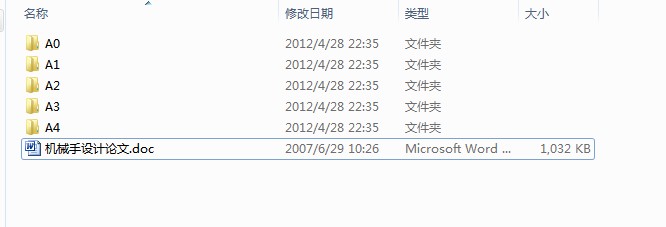機(jī)械手設(shè)計(jì)畢業(yè)全套論文
- 文件介紹:
- 該文件為 rar 格式���,下載需要 20 積分
-


- 摘 要
隨著機(jī)器人在各個(gè)領(lǐng)域應(yīng)用的日益廣泛�,許多場(chǎng)合要求機(jī)器人具有力控制的能力��。此次設(shè)計(jì)是針對(duì)回轉(zhuǎn)殼體內(nèi)自動(dòng)粘貼膠片的任務(wù)��,設(shè)計(jì)一個(gè)3—DOF平面關(guān)節(jié)型機(jī)械手(包括1個(gè)移動(dòng)關(guān)節(jié)��,2個(gè)轉(zhuǎn)動(dòng)關(guān)節(jié)和末端執(zhí)行機(jī)構(gòu))��,配合殼體驅(qū)動(dòng)系統(tǒng)來(lái)實(shí)現(xiàn)此任務(wù)�。在機(jī)械手工作過(guò)程中,通過(guò)伺服電機(jī)帶動(dòng)絲杠轉(zhuǎn)動(dòng)����,從而來(lái)完成機(jī)械手水平方向的移動(dòng),旋轉(zhuǎn)關(guān)節(jié)1通過(guò)鏈傳動(dòng)來(lái)完成平面內(nèi)的旋轉(zhuǎn)動(dòng)作���,旋轉(zhuǎn)關(guān)節(jié)2直接在伺服電機(jī)的驅(qū)動(dòng)下完成平面內(nèi)的旋轉(zhuǎn)動(dòng)作�,這樣機(jī)械手可以伸入口徑較小的回轉(zhuǎn)殼體內(nèi)完成粘貼膠片的任務(wù)。
本次設(shè)計(jì)工作首先對(duì)機(jī)械手進(jìn)行了運(yùn)動(dòng)學(xué)分析(包括運(yùn)動(dòng)學(xué)方程的建立����,運(yùn)動(dòng)學(xué)方程的正問(wèn)題�、逆問(wèn)題及其解)。設(shè)計(jì)內(nèi)容包括機(jī)械手的移動(dòng)關(guān)節(jié)����、旋轉(zhuǎn)關(guān)節(jié)的結(jié)構(gòu)設(shè)計(jì),傳動(dòng)部分的設(shè)計(jì)等��。其中��,重點(diǎn)是對(duì)伺服進(jìn)給系統(tǒng)的設(shè)計(jì)(包括工作臺(tái)的設(shè)計(jì)�����,絲杠的設(shè)計(jì)���,直線(xiàn)導(dǎo)軌�、伺服電機(jī)和減速器的選取等)�����。最后對(duì)系統(tǒng)中主要部件的剛度、強(qiáng)度等性能參數(shù)進(jìn)行了計(jì)算與校核����。
關(guān)鍵詞:機(jī)械手;自由度����;運(yùn)動(dòng)學(xué)分析;伺服電機(jī)���;直角減速器
Abstract
With the increasing application of robot in various industrial fields, it is requested that robot has the ability to control power. According to the contact task of rotary hull, a 3-DOF robot manipulator is designed in order to accomplish sticking of the colloid. The robot manipulator consists of a transfer joint and two revolute joints and robot end-effector. The robot manipulator could realize the contacting task combining with the driving system of rotary hull. The concrete processing comprising of driving screw transmission with the servo motor. In this way, robot manipulator could complete movement in horizontal direction, the revolute joint could be able to accomplish revolute motion of two dimension-space through a chain driving, the revolute joint of end-effector completes directly revolute motion with the servo motor.
Firstly, this design has been carried on the kinematics’ analysis in order to the manipulator, which consists of including the establishment of kinematics equation, the positive solutions of the kinematics equation, the corresponding inverse solutions. Secondly, the transfer joint, revolute joint and the transmission part are designed. The important part is the design of servo feeding system, which consists of the design of the platform and the screw, the selection of linear guide way, servo motor and reducer, etc. Finally, the corresponding calculations are done considering the system's main guide line such as components stiffness, strength and other performance parameters.
Keywords: Robot manipulator��;Freedom���;Kinematics analysis;Servo motor��;Right-angle reducer
目 錄
1 引言 1
1.1 課題背景和意義 1
1.2 國(guó)內(nèi)外研究現(xiàn)狀 1
1.3 工業(yè)機(jī)械手的用途 3
2 機(jī)械手結(jié)構(gòu)的總體方案設(shè)計(jì) 4
2.1 課題的主要內(nèi)容 4
2.2 課題的研究方案 4
2.3 機(jī)械手結(jié)構(gòu)的總體設(shè)計(jì) 4
2.3.1 主要技術(shù)指標(biāo)設(shè)計(jì) 4
2.3.2 機(jī)械手的結(jié)構(gòu)設(shè)計(jì) 4
3 機(jī)械手運(yùn)動(dòng)學(xué)分析 6
3.1 機(jī)械手運(yùn)動(dòng)學(xué)方程的建立 6
3.2 運(yùn)動(dòng)學(xué)方程的正解 7
3.3 運(yùn)動(dòng)學(xué)方程的逆解 8
4 傳動(dòng)裝置的設(shè)計(jì) 10
4.1 伺服電機(jī)及減速器的選擇 10
4.1.1 機(jī)電領(lǐng)域中伺服電機(jī)的選擇原則 10
4.1.2 旋轉(zhuǎn)關(guān)節(jié)驅(qū)動(dòng)電機(jī)及減速器的選擇 10
4.2 鏈輪的設(shè)計(jì)及鏈條的選擇 11
4.2.1 滾子鏈傳動(dòng)的設(shè)計(jì) 11
4.2.2 鏈輪的設(shè)計(jì) 13
4.2.3 滾子鏈的靜強(qiáng)度計(jì)算 14
4.2.4 鏈傳動(dòng)的張緊 15
4.2.5 鏈傳動(dòng)的潤(rùn)滑 15
5 軸的設(shè)計(jì)與驗(yàn)算 16
5.1 軸的結(jié)構(gòu)設(shè)計(jì) 16
5.1.1 選擇軸的材料 16
5.1.2 初步估計(jì)軸徑 17
5.2 軸的校核 18
6 軸上零件的選擇與計(jì)算 25
6.1 鍵的選擇與鍵聯(lián)接強(qiáng)度校核 25
6.1.1 大臂末端電機(jī)軸上鍵的選擇與校核 25
6.1.2 軸上矩形花鍵的選擇與校核 26
6.1.3 小臂電機(jī)軸上鍵的選擇與校核 26
6.2 滾動(dòng)軸承的驗(yàn)算 26
6.2.1 確定軸承的承載能力 27
6.2.2 計(jì)算當(dāng)量動(dòng)載荷 28
6.2.3 校核軸承壽命 28
7 伺服進(jìn)給系統(tǒng)的設(shè)計(jì)與計(jì)算 29
7.1 滾珠絲杠的設(shè)計(jì) 29
7.1.1 材料的選擇 29
7.1.2 耐磨性計(jì)算 29
7.1.3 螺桿的強(qiáng)度計(jì)算 30
7.1.4 螺桿的穩(wěn)定性計(jì)算 30
7.2 絲杠副的選擇計(jì)算 31
7.2.1 螺母的疲勞壽命計(jì)算 32
7.2.2 螺母螺紋牙的強(qiáng)度計(jì)算 33
7.2.3 螺母凸緣的強(qiáng)度計(jì)算 34
7.3 絲杠驅(qū)動(dòng)電機(jī)的選擇 34
7.4 機(jī)械導(dǎo)軌的選擇 35
7.5 聯(lián)軸器的選擇與計(jì)算 36
7.5.1 選擇聯(lián)軸器的類(lèi)型 36
7.5.2 聯(lián)軸器的主要參數(shù) 37
7.5.3 聯(lián)軸器的計(jì)算扭矩 37
結(jié)論 39
致謝 40
參考文獻(xiàn) 41
附錄A 42
附錄B 48
...

 熱門(mén)關(guān)鍵詞:
熱門(mén)關(guān)鍵詞: 


